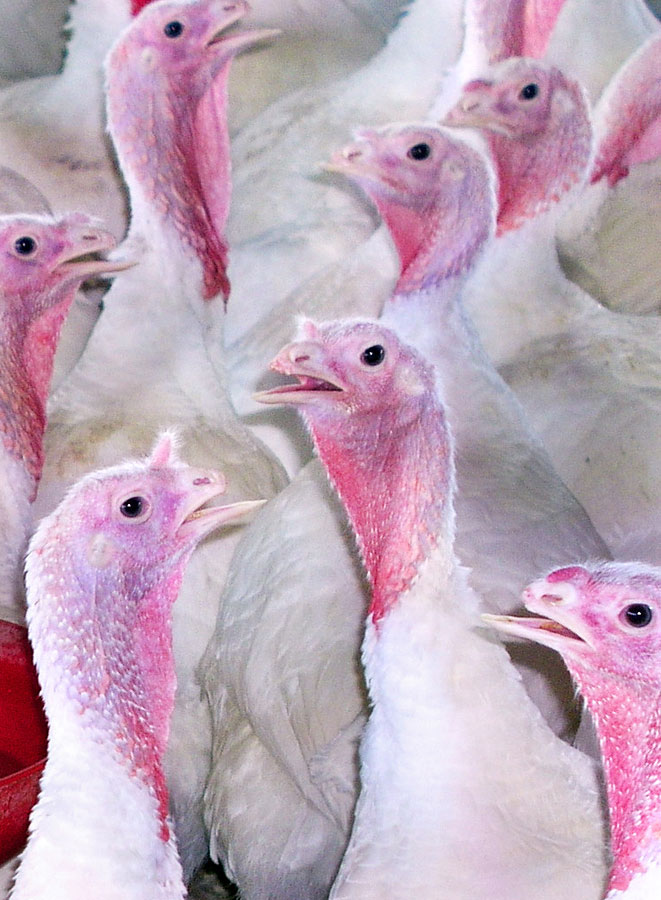Turkey Genome Sequencing Consortium awarded grant from United States Department of Agriculture

Virginia Tech and the University of Minnesota have been awarded a two-year, $908,280 grant by the United States Department of Agriculture (USDA) to complete sequencing the genome of the domesticated turkey, Meleagris gallopavo.
The funding will be used by the Turkey Genome Sequencing Consortium to complete the genome sequencing using next-generation sequencing platforms, assemble the genome sequence, and identify genes and functions in the final genome sequence by use of a sophisticated annotation pipeline. The award will also help put in place a bioinformatics and comparative genome resource for both chicken and turkey.
Rami Dalloul, assistant professor of poultry immunology in the Department of Animal and Poultry Sciences at Virginia Tech, remarked: “We are very pleased that the USDA has recognized the value of this strong community-driven effort to fully sequence the turkey genome. The award supports our continued research effort over the next two years to put in place a gold-standard genome sequence for the turkey.” He added: “The work funded by this grant will take us a long way towards our longer-term goal of discovering ways to improve the immune competence of the turkey. It will also provide invaluable information that will help develop new, more effective strategies for disease prevention.”
Otto Folkerts, associate director of technology development at the Virginia Bioinformatics Institute at Virginia Tech, commented: “A year ago we announced the start of this project, and since then we have expanded our original consortium by addition of other community stakeholders and experts. Most importantly, two groups, one at the USDA Agricultural Research Service’s Beltsville Agricultural Research Center led by Curt van Tassell and Julie Long, and the other at the University of Maryland Center for Bioinformatics and Computational Biology led by Steven Salzberg and Jim York, have made substantial contributions to this project. As a result of this combined effort, we have now generated about 90 percent of the genome sequence and we plan to release the preliminary data to GenBank at the earliest opportunity to make it available to the scientific community.”
Turkey is the fourth-most economically important source of meat for consumers in the United States. The genome sequence and genomic resources should provide turkey breeders with the tools needed to improve commercial breeds of turkey for production traits such as meat yield and quality, health and disease resistance, fertility, and reproduction.
Ed Smith, professor in the Department of Animal and Poultry Sciences at Virginia Tech, commented: “Over the years, the USDA has funded several projects that have been instrumental in establishing a framework for the complete sequencing and assembly of the turkey genome. The new award provides the crucial support needed to put in place a definitive genetic map of the turkey genome, a map that will serve as a vital resource for the poultry community and other interested scientists around the world.”
Kent Reed, associate professor of veterinary and biomedical sciences at The University of Minnesota, commented: "An exciting prospect of this sequencing effort is the ability to compare the turkey genome with those of other species. Results from the initial sequencing are already making an impact on our research. The new sequence will not only provide information on the turkey genome, but will also help refine the chicken genome sequence.”
The original participants in the Turkey Genome Sequencing Consortium include: Dave Burt of the Roslin Institute, University of Edinburgh; Roger Coulombe of Utah State University; Rami Dalloul, Audrey McElroy, Ed Smith, and Eric Wong of the Department of Animal and Poultry Sciences, College of Agriculture and Life Sciences at Virginia Tech; Jerry Dodgson of Michigan State University; Oswald Crasta, Clive Evans, and Otto Folkerts at Virginia Bioinformatics Institute at Virginia Tech; Rick Jensen in the Department of Biological Sciences, College of Science at Virginia Tech; Kent Reed at the University of Minnesota; Steven Salzberg, James Yorke, Aleksey Zimin of the University of Maryland; and Curt van Tassell and Julie Long of the USDA Beltsville Agricultural Research Center.




